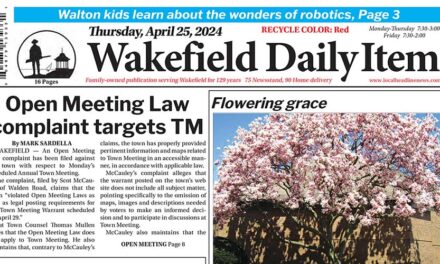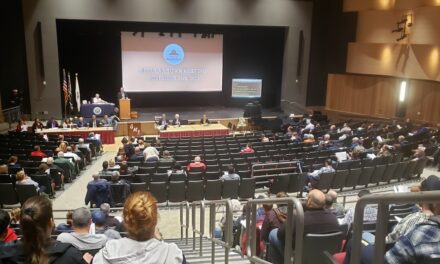Published in August 19, 2015 edition
By MARK SARDELLA
WAKEFIELD — Despite a vigorous legal debate at last night’s Conservation Commission meeting, the location of a wetland boundary at 94 Butler Ave. remains in dispute.
Attorney Brian McGrail said he represented Mike Prousalis and Mike Zammitti of Woods, LLC related to an Abbreviated Notice of Resource Area Delineation (ANRAD) from the commission. An ANRAD establishes the location of a wetland boundary, usually in advance of property development.
The bone of contention comes from the fact that the site was illegally filled in the early 1970s, an act that the Conservation Commission says altered the natural wetland and changed the location of the wetland boundary.
The Commission maintains that the wetland boundary should be set to where it would be if the area had never been filled. McGrail and his client say that the fill material effectively changed the location of the wetland boundary and the delineation should reflect that change.
The illegal fill reportedly includes demolished remains of the Atwell Building of the old Wakefield High School on Main Street, which was destroyed by fire on Dec. 12, 1971. Testing has shown the fill material to contain concrete, rebar, brick, burnt wood, asphalt pieces, metal, ash, roofing shingles, tires and blue plastic to depths of 8-10 feet. It is unclear who dumped the material in the vacant lot or who authorized the dumping.
Plans for the site include removing at least some of the fill and replacing it with clean fill.
McGrail maintained that the Conservation Commission did not have the jurisdiction to re-establish the original wetland boundary.
He introduced environmental consultant Ann Marton to explain that laws passed since 1990 preclude the commission from ordering fill placed before that date to be removed, so the newly delineated wetland line is now the legal boundary. The law does not apply to fill placed before 1990 and the wetland line does not go back to what it was before the fill was placed, Marton argued.
ConCom member Peter Miller, an attorney, countered that the 1990 Grant Amendment cited by Marton was based on a criminal case and applied only to enforcement actions, not to ANRADs. He cited a regulation that he said required the commission to establish the wetland line at the pre-fill boundary.
But McGrail countered that the fill placed there before 1990 is legal fill. He said that the area in question is no longer wetland.
Commissioner David Peterson, also an attorney, agreed with Miller that the law cited by Marton does not apply to wetland delineation.
“Until you can show us that this is directly applicable, I’m not going to vote to approve (the new wetland delineation). It’s not going to happen tonight unless you produce additional evidence.”
Rather than have the Commission vote last night, Marton said that she would prefer to take two weeks to gather more information to try to sway the commission to her point of view.
Peterson said, “I’d love for you to convince us.”
The hearing was continued to Sept. 3.
—————
The Commission met with representatives of the Heron Pond Condominium Association to discuss their turf management plan as it impacts the nearby Heron Pond wetland.
Attorney Thomas Fiore and engineer Ryan Bianchetto agreed to tweak the condo association’s turf management plan to comply with a new law that went into effect earlier this year. They maintained that their current plan was already largely consistent with the regulations.
Commission members wanted assurances that the buffer zone to the wetland would be maintained in such a way as to maximize the uptake of nutrients before they impact the wetland.
Fiore and Bianchetto agreed to review existing conditions and submit an amended turf management plan before the commission’s next meeting.
—————
Attorney Philip Posner represented Kevin Horrigan of 5 Findlay St. in another case of fill placed in a wetland.
Posner said that the fill was brought in years ago and encroached on a wetland. He said that Horrigan was now prepared to set things right and pull the fill back away from the wetland.
However, Posner said there was some uncertainty regarding the flood plain elevation on the site. The actual flood plain elevation, he said, would determine exactly how much fill Horrigan would have to remove.
The commission agreed to wait another month or so for the expected results of a town-wide drainage study, which may settle the flood plain elevation question.
The hearing was continued to Oct. 1.




